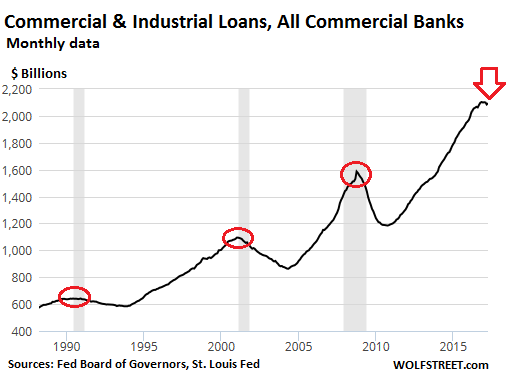Oops, this Wasn’t Supposed to Occur in a Rosy Credit Scenario
by Wolf Richter, Wolf Street:
 It’s always associated with a recession: last time, the Financial Crisis.
It’s always associated with a recession: last time, the Financial Crisis.
Over the past five decades, each time commercial and industrial loan balances at US banks shrank or stalled as companies cut back or as banks tightened their lending standards in reaction to the economy they found themselves in, a recession was either already in progress or would start soon. There has been no exception since the 1960s. Last time this happened was during the Financial Crisis.
Now it’s happening again – with a 1990/91 recession twist.
Commercial and industrial loans outstanding fell to $2.095 trillion on May 10, according to the Fed’s Board of Governors weekly report on Friday. That’s down 4.5% from the peak on November 16, 2016. It’s below the level of outstanding C&I loans on October 19. And it marks the 30th week in a row of no growth in C&I loans.
Based on the Fed’s monthly reports, C&I loans outstanding at the end of April, at $2.095 trillion, were down a smidgen from October’s $2.098 trillion and were down 4.3% from the peak in November. This marks the seventh month in a row of no growth in loans.
This chart shows C&I loans outstanding at all US banks going back to 2012. Note how that 30-week stagnation-period is unique in this time span:

Since the Financial Crisis, the mantra has been: credit growth no matter what. Businesses have been exhorted to borrow, money has been cheap, and borrow they did. There have been periods of four or five weeks of stalling C&I loan growth, only to be succeeded by a vigorous surge. But after ballooning in this manner for six years straight, C&I loans have now languished for 30 weeks. And it’s not the oil bust; banks are lending to the oil patch again.
C&I loans are tightly connected to the real economy. They’re an indication of what businesses are up to, from a shop needing a loan to buy a piece of equipment to the multinational funding its receivables. C&I loans show whether companies in aggregate are expanding their needs and activities or whether they’re curtailing them.
The chart below shows how any significant decline of C&I loans outstanding in the debt-addicted US economy is associated with recessions. Note the turning points:

What happened during the Financial Crisis was, let’s say, special: Credit froze up, banks stopped lending, businesses stopped asking for loans, and C&I loans fell off a cliff. More typical scenarios would be the prior two recessions. In 2001, C&I loans peaked in February 2001 and then declined. The official recession began in March 2001 and ended in November 2001. But C&I loans kept falling until May 2004.



